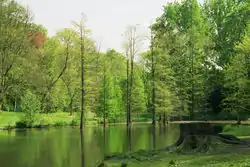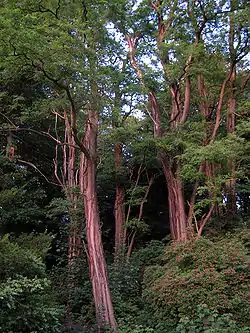Botanischer Garten Rombergpark
The Botanischer Garten Rombergpark, or informally Rombergpark, is an extensive municipal arboretum and botanical garden located at Am Rombergpark 49b, Dortmund, North Rhine-Westphalia, Germany. With its total area of 65 hectares the Rombergpark is one of the largest botanical gardens in the world. It is open daily.


The garden was established in 1822 as the Romberg family's English landscape park. In 1927-1929 it was acquired by the city and under city planning director Richard Nose enhanced by a small herb garden. The park and castle were badly damaged in World War II, but starting in 1950 director Gerd Krüssmann rebuilt it as an arboretum, adding some 4500 species to the park. In 1958 the park's greenhouses were built, and in 1985 a garden of medicinal plants was added.
Today the garden contains a historic English landscape park with monuments; an arboretum containing thousands of species of woody plants, including some of the largest trees in North Rhine-Westphalia; a terrace with palm trees; and four greenhouses (1000 m² total area) for cactus and succulents, ferns, tropical plants, and camellias, jasmine, and lemons.
In 1945, shortly before the end of World War II, officers of the Gestapo murdered almost 300 people in the Rombergpark and the nearby forest Bittermark. The victims were mostly forced labourers and prisoners of war from several European countries, as well as previously imprisoned opponents of the National Socialist government. These events are commemorated today at the Mahnmal Bittermark.
See also
External links
 Media related to Rombergpark at Wikimedia Commons
Media related to Rombergpark at Wikimedia Commons- Botanischer Garten Rombergpark
- Stadt Dortmund: Botanischer Garten Rombergpark
- Freunde und Förderer des Botanischen Gartens Rombergpark